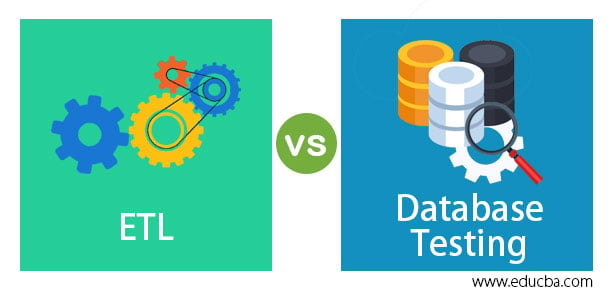Updated July 4, 2023
Difference Between ETL Vs Database Testing
Before we even get into the testing genre of ETL or DB, let us be fully aware of what each of them essentially signifies in the real world. ETL stands for Extract, Load, and Transform. It takes care of the end-to-end process of loading data from the source system to the data warehouse. Now, there might be a question about what is a data warehouse. The data warehouse is that “Database” about the testing, which will be discussed in this article. This warehouse is built by integrating data from different sources, homogenous or heterogeneous in nature, and constructed so that high-quality information is retained, which in the process would help report requirements of all levels.
For example, there might be daily data on the interaction of an organization with its customers, employees, finances, and so on. All these data reside as different files or tables or whatever digital data one would keep it. ETL will ensure that all these data are processed and only high-quality information is kept for further usages like Reporting, Analysis, Quality check and interpretation, and many more Business Intelligence.
Head to Head Comparisons Between ETL Vs Database Testing (Infographics)
Below are the top comparisons between ETL and Database Testing:
Understanding ETL and Database Testing
There are a few steps that are an essential part of the ETL process, which we will go through as it will help us understand the differences which would come up in testing.
Then we move to the next step of Transform. This is where many operations happen on the data to make it viable, high-quality data. In this step, it is first transformed into a Data Warehouse format. This is to ensure that there should be a column that identifies the row as unique. A data warehouse owns these keys, and no entity can assign them. In the last part of the transform step, we cleanse the data of unwanted errors that might have crept during transformation making it ready for loading.
Key Differences Between Lightroom CC vs Lightroom Classic
- The first genre is the intention behind the testing of each. ETL testing is intended to have an impact on BI reporting, and all the steps of ETL (Extract, Load, and Transform) need to be tested so that the data is ready for BI reporting. In database testing, the testing is done on validating and integrating the data. This is to check if there are valid values in the column of the database. For example, a date column can’t have any invalid data like a string value or a date from the 1400s.
- Now that we know the intention behind each test, one should know its importance in the business. Of course, without importance, the survival of the process is difficult in a business flow that tries to optimize the days to turn around a minimum viable product into the market. Database testing helps in keeping a check on the integration of data from different sources into one place, whereas on the other hand, ETL testing is more to test out the data we have extracted is viable and important for BI reporting.
- The third genre is understanding which systems are applicable for each type of testing. ETL testing is applicable for those systems where historical data is present and not necessarily a business flow environment, and on the contrary, ETL testing needs to be performed on a system with an active transactional system where there is business flow.
- This ensures we enable the capability of complex analysis and ad hoc queries. And for Database testing, we use an ER (Entity Relationship) model where data elements and their relationships are defined.
- OTLP is a system that helps in a quick update, insert and delete while the process of transaction is still active.
- The data we handle for ETL testing is more denormalized data with more indexing and aggregation rather than joins, whereas, in Database testing, the data has a lot of joins because they come from a wide variety of sources.
- In the end, the common tools for ETL testing which help in automation are QuerySurge and Informatica, and for Database testing, Selenium and QTP are widely used.
Comparison Table of ETL Vs Database Testing
Let’s look at the top comparisons between ETL Vs Database Testing.
| Genre | ETL Testing | Database Testing |
| Intention | Tested with the intent to have better BI reporting | Tested with the intent to have proper data in columns |
| Importance in Business | If the data is viable and important from a BI perspective | If data is integrated properly, as they come from a wide variety of sources |
| Systems applicable | Systems with historical data | Systems with more transactional data |
| Model used for testing | Multidimensional model | Entity-Relationship model |
| Database type | OLAP database, as it consists of a mostly historical type of data | OLTP database as it comprises mostly transactional data. |
| Data type | Denormalized data with a lot of indexes and aggregation | Normalized data consists of a lot of joins. |
| Examples of tools | QuerySurge, Informatica | Selenium, QTP |
Conclusion
In a nutshell, this article gives you an in-depth understanding of what basic differences to look at while deciding the testing you would need to flow in your professional work and plan your testing architecture in such a way that essential components don’t get missed during the flow, else in production critical scenarios might come in and lead to a loss in the lifecycle of the software.
Recommended Articles
This is a guide to ETL Vs Database Testing. Here we discuss the key differences with infographics and the ETL Vs Database Testing comparison table. You can also go through our other related articles to learn more –




